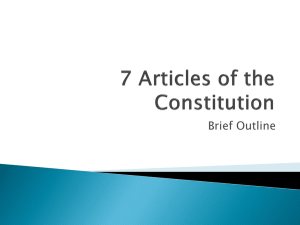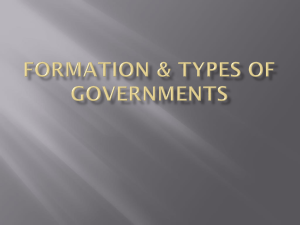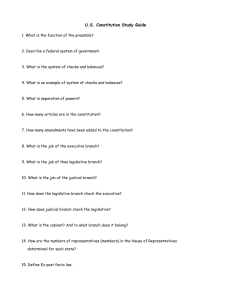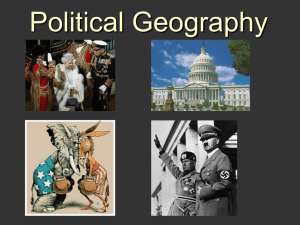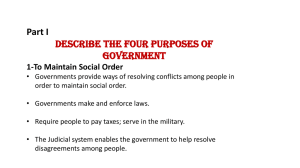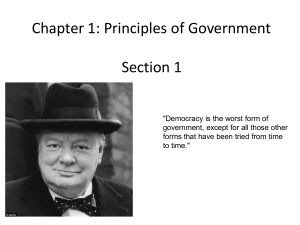Principles of Government
advertisement
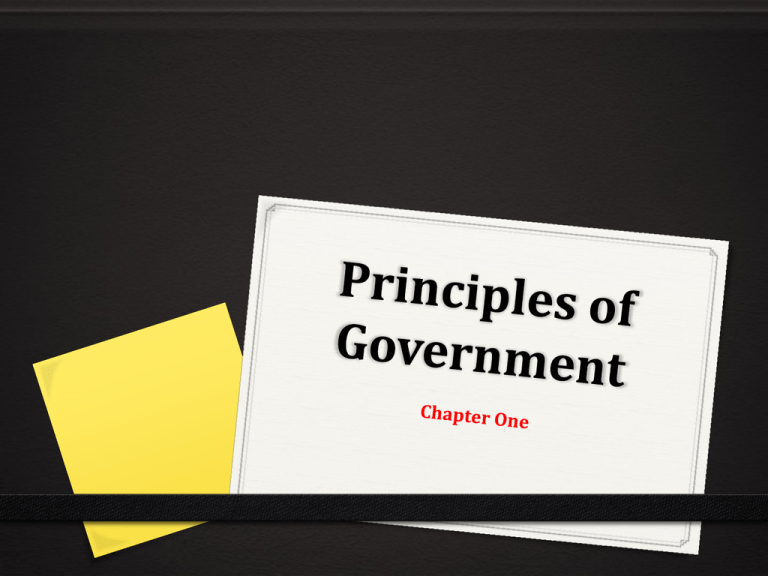
Government and the State Section One Government is the institution through which a society makes and enforces its public policies—all those things a government decides to do. 0 Every government has three kinds of power: 0 legislative power, or the power to establish law 0 executive power, or the power to carry out the law 0 judicial power, or the power to interpret laws and settle disputes. 0 These powers are often outlined in a constitution—the body of laws that sets out a government’s structure, principles, and processes. In a dictatorship, one person or a small group may exercise all the powers of government. In a democracy, supreme authority over government rests with the people. The world’s dominant political unit is the state—a body of people living in a defined territory, often called a nation or country. Four Characteristics of a State: Population A state must have people, the number of which does not directly relate to its existence. Sovereignty Every state is sovereign. It has supreme and absolute power within its own territory and decides its own foreign and domestic policies. Territory A state must be comprised of land—territory with known and recognized boundaries. Government Every state has a government — that is, it is politically organized. Again, every state has a sovereign government, or one with absolute power. What brought about the state as institution to govern the people? There are four main theories that address the answer to this question. First, The Force Theory explains that the state was born when a person or a small group claimed control over an area and forced all within to submit to rule. Next, The Evolutionary Theory gave the explanation of family structure leading to government following the pattern of leadership. The third concept is The Divine Right Theory stated that God created the state and gave those of royal blood the right to rule. Finally, The Social Contract Theory explains that government is developed as the people trade freedom for protection and the meeting of individual needs. The Preamble to the U.S. Constitution describes the goals of the United States’ Federal Government. “We the People of the United States, in Order to form a more perfect Union, establish Justice, insure domestic Tranquility, provide for the common defence, promote the general Welfare, and secure the Blessings of Liberty to ourselves and our Posterity, do ordain and establish this Constitution for the United States of America.” It says that government should form a more perfect union, or keep the States working together; establish justice; ensure domestic tranquility, or keep order; provide for the common defense; promote the general welfare; and secure the blessings of liberty. Forms of Government Section Two Government may be classified in three ways. The first is defined by who may participate in the government. 0 In a democracy, supreme political authority rests with the people. 0 All dictatorships are authoritarian, meaning that the ruler holds absolute authority over the people. 0 A dictatorship may be totalitarian, meaning that the rulers control nearly every aspect of human affairs. 0 Dictatorships may also be an autocracy—in which one person holds unlimited political power—or an oligarchy—in which a small elite holds the power to rule. The second classification is defined by where government power is held. 0 In a unitary government, a single, central agency holds all government powers. 0 In a federal government, a central government and several local governments share governmental powers in a division of powers. 0 The Constitution divides power between the National Government and the States, so the United States is a federal government. A federal system is different from a confederation, which is an alliance of independent states. The third type of classification describes the relationship between the legislative and executive branches of government. A presidential government divides, or shares, power between the branches, while a parliamentary government focuses power on the legislative branch. In the parliamentary government, the executive branch is chosen by and subject to the legislative branch. Basic Concepts of Democracy Section Three 0 The American “concept of democracy” rests on five basic notions: 0 Each individual has worth. 0 All individuals are equal. 0 The majority of the people rules, but the majority must respect the rights of any minority. 0 Compromise is necessary. 0 Each individual must have the widest possible degree of freedom. 0 The American commitment to freedom is evident in the nation’s economic system. It is often referred to as free enterprise. 0 The free enterprise system is based on private ownership, individual initiative, profit, and competition. Also known as capitalism, this system does not rely on the government to make economic decisions. 0 Instead of government, free enterprise relies on individuals making those decisions through the law of supply and demand. 0 The law of supply and demand states that when supplies of goods and services become plentiful, prices then to drop; when supplies become scarcer, prices tend to rise. 0 The American economic system is most accurately called a mixed economy because the United States government does play a role in the economy by regulating and promoting it. End Chapter One


